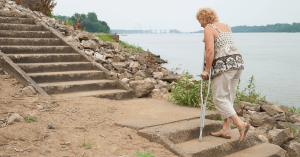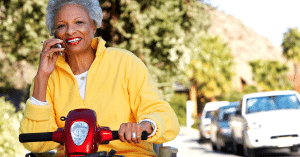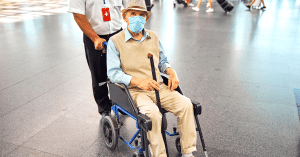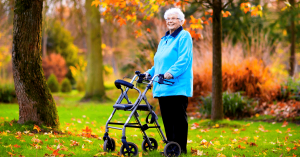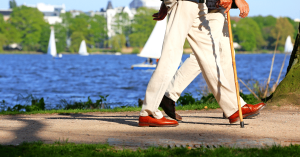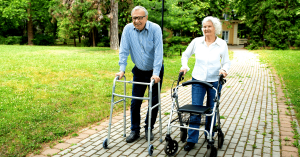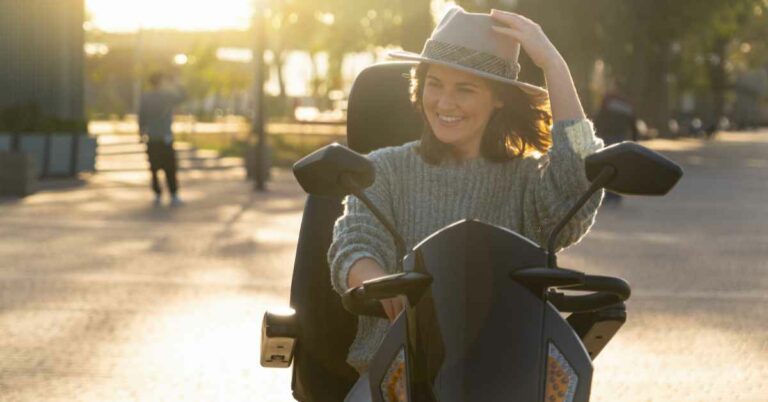
As a physio, I’ve been teaching people how to use crutches for many years so I’ve seen it all and heard every question people have about crutches.
Is this your first time using crutches? Do you want to be safe and make sure you are using them correctly? Or maybe you just need a refresher on your technique?
If so, you’re in the right place – read on!
Table of Contents
Toggle1. How to measure your crutches
Before you can use your crutches you need to make sure they are the right height for you and adjusted correctly.
Have you got underarm crutches or forearm crutches? Follow the different methods below.
Underarm crutches
- The tops of the crutches should be about 2 inches (or 3 fingers width) below your armpit when you are standing in a relaxed upright position
- The hand grips should be roughly level with your wrist when your arm is resting down by your side (not on the crutch)
- When you have your hand on the hand grips you should have a slight bend in your elbow and your shoulder should be relaxed down away from your ear
Forearm crutches
- The handles should be roughly level with your wrist when your arm is resting down by your side (not on the crutch)
- The handles should be pointing forwards in the direction you will be going, like headlights on a car
- The forearm cuff should be an inch or so below your elbow
- When you have your hand on the hand grips you should have a slight bend in your elbow and your shoulder should be relaxed down away from your ear
So that’s how crutches adjust, for the two main types of crutches.
2. Types of weight bearing
How you use crutches will depend on how much weight (if any) you are allowed to put on your leg.
But how do I know what my weight bearing status is? I hear you ask. Well, if there is any restriction to how much weight you can put through your leg you would have been told this by a doctor – often an orthopaedic surgeon if you have had surgery or a fracture.
See the four types of weight bearing below so you know what you are and aren’t allowed to do.
Full Weight Bearing/Weight bearing as tolerated (FWB/WBAT)
Partial Weight Bearing (PWB)
Partial weight bearing means you are only allowed to put some of your weight through your leg, not all of it. Generally, unless told otherwise, partial weight bearing means 50% weight bearing. So you can put up to half your weight through your leg and the rest needs to go through your crutches.
You can stand normally without crutches when partial weight bearing because half of your weight is going through your other leg naturally. It’s only when you start to walk that you have to be careful how you use the crutches.
Touch Weight Bearing (TWB)
Touch weight bearing (sometimes called touch toe weight bearing) means you can touch your foot down on the ground very lightly but you are not allowed to put any weight through the leg.
Imagine there is an egg on the ground – you can touch it lightly with your toes but don’t put weight through or you will crack the egg shell.
Or my personal favourite: imagine there is a bumble bee on the ground and you can touch it’s wing very lightly with your toes but don’t squash it!
Touch weight bearing can help you to balance as you can still feel the ground, which can help some people feel more steady when on their crutches. [7]
Non Weight Bearing (NWB)
Non weight bearing means you are not allowed to put any weight through the leg at all until you are told otherwise.
This means that your bad/injured leg will be off the ground completely and you will be using the crutches and your good leg only to get about.
3. How to walk with crutches
Now you know what your weight bearing status means, see below for how to walk with your crutches.
How to walk with crutches full weight bearing (FWB)
- You can stand normally with equal weight through both legs
- Bring both your crutches forward at the same time about a step length in front of you (maybe a foot or so). Make sure your crutches aren’t directly in front of your feet but slightly out to the side so you don’t kick them when you’re walking!).
- Take a step forward with your bad leg so it’s roughly in line with the crutches, putting abit of weight through the crutches if you need to due to pain or discomfort.
- Bring your good leg in line with your bad leg and crutches
- Then start over by moving the crutches forward first!
How to walk with crutches partial weight bearing (PWB)
- You can stand normally with equal weight through both legs
- Move your crutches forwards first
- Step your bad leg forwards to meet the crutches (put half of your weight through the crutches so only half of your weight is on the leg)
- As you step the good leg forwards make sure you are weight bearing heavily through the crutches to take half of the weight off the bad leg.
How to walk with crutches touch weight bearing (TWB)
- Stand with the toes of you injured leg lightly touching the ground only (use your crutches to balance)
- Crutches forward first
- Bad leg (put all your weight through the crutches, your toes are touching the ground lightly for balance only)
- No weight on the bad leg at all (all the weight through the crutches) as you step the good leg forwards.
Top Tip: Some people find this hard to get their heads around – if this is you, you might find it easier to just non weight bear instead (see below).
How to walk with crutches non weight bearing (NWB)
- Stand with your crutches with your injured leg off the ground completely (with your knee bent so your foot is back behind you slightly)
- Move your crutches forwards
- Put all your weight through the crutches as the good leg hops to the crutches. Your bad leg stays off the ground and out of the way the whole time.
Top Tip: Don’t feel safe trying to non weight bear with crutches? If so, you may benefit from using a walking frame instead whilst you’re non weight bearing. It may make you feel safer and steadier (see how to use a walker like an expert).
4. How to do stairs on crutches
Have you got stairs or steps at home? Are you wondering how to get up and down them safely with crutches?
The technique is slightly different depending on whether you have a rail to hold onto or not.
If you have a rail, you will need to be able to hold both crutches in one hand to leave the other hand free to hold the rail. Normally the best way of doing this is to make a T shape with your crutches.
This is where you have one crutch on properly (as you will need to use it on the stairs) and the other crutch at a right angle to this. You then hold onto the handle of the crutch you are using and the other crutch at the same time.
Please watch the start of the video below to see how to do this, as it can be a little confusing to explain!
Top Tip: Some people really can’t get on with holding both crutches in one hand. If this is you, you will need a third crutch.
Then when you are going up the stairs you will leave one crutch at the bottom of the stairs and just use one crutch and the rail to go up.
Then when you are at the top of the stairs take the third crutch that is waiting there for you for using to walk about upstairs.
See below for how to do stairs with crutches no matter what your weight bearing status is. The same rules apply whether you are indoors or outdoors.
How to use crutches on stairs fully weight bearing (FWB)
Going up stairs
With a rail:
- Hold both crutches in one hand and the rail with the other hand
- Step up onto the first step with your good leg
- Then step up onto the same step with your bad leg
- Then bring your crutch up onto the same step as your legs
Without a rail:
- Have a crutch in each hand
- Step up with your good leg
- Step up with your bad leg
- Bring both crutches up to the same step as your legs
Coming down stairs
With a rail:
- Hold both crutches in one hand and the rail with the other hand
- Put your crutch down on the first step
- Then step down onto the same step with your bad leg
- Then bring your good leg down onto the same step as your bad leg and crutch
Without a rail:
- Have a crutch in each hand
- Put both your crutches down onto the first step
- Step down onto the same step with your bad leg
- Then bring your good leg down onto the same step as your bad leg and crutches
So that’s how to use stairs with crutches!
How to use crutches on stairs partially weight bearing (PWB)
Going up stairs
With a rail:
- Hold both crutches in one hand and the rail with the other hand. You can stand normally whilst both legs are on the same step as your good leg will be taking half the weight naturally.
- As you step up onto the first step with your good leg you have to make sure that the crutch and the rail are taking half the weight out of the bad leg.
- Then step up onto the same step with your bad leg
- Then bring your crutch up onto the same step as your legs
Without a rail:
- Have a crutch in each hand
- Step up with your good leg making sure the crutches are taking half the weight out of the bad leg
- Step up with your bad leg
- Bring both crutches up to the same step as your legs
Coming down stairs
With a rail:
- Hold both crutches in one hand and the rail with the other hand. You can stand normally whilst both legs are on the same step as your good leg will be taking half the weight naturally.
- Put your crutch down on the first step
- Then step down onto the same step with your bad leg, making sure the crutches are taking half the weight out of the bad leg
- Then bring your good leg down onto the same step as your bad leg and crutch
Without a rail:
- Have a crutch in each hand
- Put both your crutches down onto the first step
- Step down onto the same step with your bad leg, making sure the crutches are taking half the weight out of the bad leg
- Then bring your good leg down onto the same step as your bad leg and crutches
How to use crutches on stairs touch weight bearing (TWB)
This is how to go up and down stairs properly touch weight bearing. However, in my experience I have found that most people struggle with this.
So most of the time I would teach stairs non weight bearing instead (see below) as it is simpler and less confusing, and therefore safer!
For your safety: If you’re not sure about this one it may be easier and safer to try non weight bearing instead – see below.
But if you want to give it a try follow the instructions and video below.
Going up stairs
With a rail:
- Hold both crutches in one hand and the rail with the other hand. No weight on the bad leg, touching the ground lightly for balance only
- As you step up onto the first step with your good leg you have to make sure that the crutch and the rail are taking all the weight out of the bad leg.
- Then step up onto the same step with your bad leg, again only lightly touching the step
- Then bring your crutch up onto the same step as your legs
Without a rail:
- Have a crutch in each hand. No weight on the bad leg, touching the ground lightly for balance only
- Hop up onto the first step with your good leg making sure the crutches are taking all the weight out of the bad leg (so you are not using the bad leg at all).
- Step up with your bad leg, only lightly touching the step
- Bring both crutches up to the same step as your legs
Coming down stairs
With a rail:
- Hold both crutches in one hand and the rail with the other hand. No weight on the bad leg, touching the ground lightly for balance only
- Put your crutch down onto the first step and hold further down the rail
- Lower your bad leg down onto the same step, touching the ground lightly only and putting all your weight through the crutch and rail
- Then step down onto the same step with your good leg
Without a rail:
- Have a crutch in each hand. No weight on the bad leg, touching the ground lightly for balance only
- Put both your crutches down onto the first step
- Lower your bad leg down onto the same step, touching the ground lightly only and putting all your weight through the crutch and rail
- Then step down onto the same step with your good leg
Top Tip: Putting your whole forearm on the rail rather than just your hand allows you to put more weight through on that side which might make it easier!
How to use crutches on stairs non weight bearing (NWB)
Going up stairs:
With a rail:
- Hold both crutches in one hand and the rail with the other hand. The bad leg is completely off the ground, out of the way behind you
- Pushing through the crutch and rail, hop up onto the first step with your good leg.
- Then bring your crutch up onto the same step
Top Tip: Again, putting your whole forearm on the rail rather than just your hand allows you to put more weight through on that side which might make it easier!
Without a rail:
- Have a crutch in each hand. The bad leg is completely off the ground, out of the way behind you
- Pushing through both crutches, hop up onto the first step with your good leg.
- Bring both crutches up to the same step as your good leg
Coming down stairs
With a rail:
- Hold both crutches in one hand and the rail with the other hand. The bad leg is completely off the ground, out of the way behind you
- Lower the crutch down onto the first step and hold further down the rail
- Pushing through the crutch and rail, lower your good leg down onto the first step
Without a rail:
- Have a crutch in each hand. The bad leg is completely off the ground, out of the way behind you
- Lower both crutches down onto the first step
- Pushing through both crutches, lower your good leg down onto the first step
For Your Safety: Going up and down stairs with crutches non weight bearing is not for everyone – it takes quite a lot of strength and can feel scary. Even young, fit and strong people find it hard. Especially first trying to hop up.
If you are non weight bearing and have to go up and down stairs then going up and down on your bottom is another option, which some people feel safer doing.
Going up and down stairs on your bottom:
The hardest part of going up and down stairs on your bottom is getting up again! So if you can do that bit, it should be fine for you.
Going up stairs:
- Turn around so the stairs are behind you and lower yourself down onto the third of fourth step using a rail or crutch to help you
- Then use your arms and your good leg to lift your bottom up onto the next step up
- Continue this all the way up taking care to keep your bad leg up if you are not allowed to weight bear through it
- Once your bottom is on the top landing, continue to shuffle backwards until you are away from the stairs
- Then use your arms, your good leg and crutches/rail to pull yourself up. This is the hardest bit as it requires a certain amount of strength. Another option is to lift yourself onto a chair before standing up fully.
Coming down stairs:
- On the top landing, lower yourself down to the ground and then shuffle your bottom towards the stairs
- Lower down each step on your bottom until you are on the second or third step from the bottom and your feet are on the downstairs landing
- Use a rail/crutch to pull yourself up
Top Tip: If you are non weight bearing and both the crutches option and bottom shuffling option are not right for you then you should perhaps consider setting yourself up to live downstairs temporarily until you are allowed to put weight on your leg.
5. How to use crutches to stand up and sit down
There’s a certain technique for standing up and sitting down with crutches to ensure you stay safe and don’t hurt your shoulders.
Standing up with crutches:
- Whilst still sitting, make a H shape with your crutches and hold onto both crutch handles with one hand (your other hand should be on the chair to help you to push yourself up)
- Push down with both arms to stand
- Once standing, separate your crutches and put them both on before walking
Sitting down with crutches:
- Once the chair is behind you, take both arms out of the crutches
- Make the H shape and hold onto both crutch handles with one hand
- Put your other arm down on the chair to help lower yourself to sitting
Top Tip: If you can’t get on with the H shape technique then the other option is to prop your crutches somewhere next to you, then use both hands on the chair to push yourself up. Then put your crutches on.
6. How to use crutches to progress my walking
Are your crutches slowing you down? Would you like to be able to pick up the pace but still need to use your crutches for now? If so, there are two other ways of how to walk on crutches that might suit you better. You can either go down to one crutch or change your gait pattern (walking pattern):
1. One crutch
Please bear in mind that if you are still non weight bearing, touch weight bearing or partial weight bearing you are not allowed to go down to one crutch, as you will not be able to support your bad leg effectively. But if you are fully weight bearing or allowed to weight bear as tolerated this could be a good option for you.
How to walk with one crutch:
- The crutch should be in the opposite arm to the bad/injured leg e.g. if you need to support your right leg, the crutch needs to be in your left hand. Otherwise you can end up leaning over onto the right side and not walking with a good upright, central walking position
- Move the crutch forward and at the same time take a step with the opposite (bad) leg
- Then step forward with the other (good) leg to either join the bad leg or step past it slightly
Top Tip: If you find that you are leaning heavily to one side when using one crutch that’s a sign that you haven’t got quite enough support and are not quite ready for one crutch.
In which case you should go back to two crutches, at least until you can walk nice and upright without leaning.
2. Alternative gait pattern
The standard walking pattern with crutches to start with is the 3 point gait pattern, as mentioned earlier in this article. This is where there are 3 points to the walking pattern:
- Move the crutches
- Move the bad leg
- Move the good leg
A progression from this is a crutches 2 point gait pattern:
- Move the crutches and the bad leg at the same time
- Move the good leg
The bad leg still gets the support it needs from the crutches but the whole walking process is a bit quicker. This is something you can try when you are already happy and confident on crutches and want to progress your speed and have a more fluid walking pattern – I tend not to teach beginners this.
In case you are interested, the crutches 4 point gait pattern just means moving each crutch and each leg separately, not in unison with each other.
7. Top safety tips when using crutches
Here are my top safety tips for when you are using crutches:
- Don’t use your crutches if they are worn out or faulty in any way – get them checked by your healthcare provider.
- Try to avoid particularly wet and icy surfaces if you can, as the rubber tips of your crutches won’t be able to grip the ground as well as normal.
- Watch out for uneven ground e.g. paving slabs when out and about – you don’t want to catch your crutches on them!
- Take care to remove or tape down bits of carpet/rugs at home that might be loose or sticking up, that you could catch your feet or crutches on.
- If you are getting numbness or tingling in your arms or hands, this is a sign that your crutches may be putting pressure on the nerves and you should get your crutches checked/adjusted.
- Wearing a backpack around the house or up and down the stairs when using crutches allows you to keep your hands free and safely on the crutches!
Frequently asked questions
Crutches are needed when:
- You are having trouble standing and walking.
If you have leg, hip or even lower back pain, taking some of your weight off your leg can help. For example, if you’ve badly sprained your ankle and can’t walk on it. Protecting the area with crutches can help with the healing as well as the pain.
- You’re not allowed to put full weight through your leg after a fracture or surgery.
If you’ve been told that you are non weight bearing, partial weight bearing or touch weight bearing, you should be using at least a pair of crutches to move around. If you don’t follow this advice you can affect the healing of your injury. Some people need more support than crutches and might use a frame.
Check out ‘How to use crutches – the ultimate guide’ to find out how to walk with crutches and get up and down stairs with different weight bearing statuses.
You can stop using your crutches when you are allowed to put full weight through your leg and have a nice walking pattern with no limping or leaning from side to side.
It might be best to progress down to one crutch or a stick first before going without any walking aid at all. Check out ‘How to use crutches – the ultimate guide‘ part 6 to learn how to do this.
If you are still partial, touch or non weight bearing you must continue to use both crutches until your weight bearing status changes – you would normally be told this by the Doctor caring for you, so check with them if you are not sure.
If you don’t feel safe when trying to walk with crutches this is likely to be for one of three reasons:
- They are not adjusted properly to suit you
- They are not being used correctly
- They are not the right walking aid for you
What to do about it:
1. and 2: Check out ‘How to Use Crutches – The Ultimate Guide‘ here for explanations and videos on how to adjust and use your crutches properly and safely.
3: Crutches aren’t right for you and that’s ok.
Crutches aren’t for everyone and there may be something more suited to you if you are feeling unsteady or worried about falling.
- For those who need a bit more support a walking frame is the next best option. See ‘How to use a walker like an expert‘ to learn more about walking frames.
- If you are under the care of a healthcare professional, speak to them and let them know you don’t feel safe and they will go through your options with you.
- They may also want to assess you in person to decide what’s best for you.
Firstly, obviously don’t use crutches that aren’t in good condition, for safety reasons.
If possible, try to contact your healthcare provider and they may be able to replace or fix them for you. Or adjust them to suit you better.
Otherwise, you can buy spare parts for some bits of your crutches, for example the rubber tips (or ferrules) on the bottom of them if they are worn out.
It is also possible to buy gel pads etc to make your crutches more comfortable to use.
Other crutches with more comfortable handles may also be available.
Fischer, or comfy handle crutches, are forearm crutches with a specially shaped handle designed to distribute pressure better and be more comfortable for painful/arthritic hands.
Also don’t forget – if you have crutches (or other walking aids) that you no longer need and are taking up space you may be able to give them to charity.
Ok, so that’s everything you need to know about how to use crutches correctly and safely!
I hope it’s been helpful for you?
Think of your crutches as your temporary extra legs – they are there to support you for as long as you need them!
What to do next?
Not sure if crutches are right for you? Or not sure if you even need a mobility aid? If so, check out some of my other guides below:
Which mobility aid is right for you? QUIZ
12 clear signs that you may need a mobility aid now!
References
[1] Kujath, A. S. 2018 ‘Crutch Fitting’, Orthopaedic Nursing, vol.37, no.4, pp 262-264
[2] Chang, I. T. and Hohler, A. D. 2012 ‘Bilateral Radial Nerve Compression (Crutch Palsy): A Case Report’, Journal of Neurology & Neurophysiology, vol. 3, issue 3, p 130
[3] Borrelli J, Haslach HW Jr. 2013 ‘Experimental characterization
of axillary/underarm interface pressure in swing-through crutch walking’, Journal of Rehabilitation Research & Development, vol. 50, no. 3, pp. 423–36.
[4] Anderson, T. B and Duong, H. 2022 [Updated 2022 May 8]. ‘Weight Bearing’. In: StatPearls [Internet]. Treasure Island (FL): StatPearls Publishing
[5] Smeeing, D.P.J., Houwert, R.M., Briet, J.P. et al. 2020 ‘Weight-bearing or non-weight-bearing after surgical treatment of ankle fractures: a multicenter randomized controlled trial’. European Journal of Trauma & Emergency Surgery vol. 46, pp. 121–130
[6] Augat, P. Hollensteiner, M. and von Rüden, C. 2021, ‘The role of mechanical stimulation in the enhancement of bone healing’, Injury,
vol. 52, supp 2, pp. 78-83
[7] Polat G, Karademir G, Akalan E, et al 2017 ‘Patient compliance with touchdown weight bearing after microfracture treatment of talar osteochondral lesions’. Journal of Orthopaedic Surgery & Research vol. 12, p 46.



